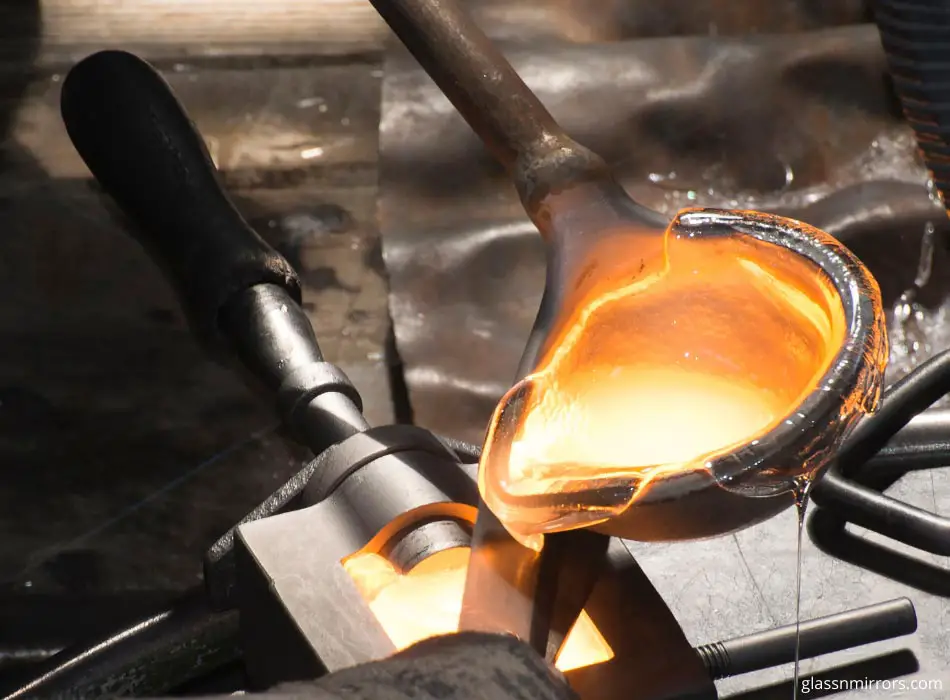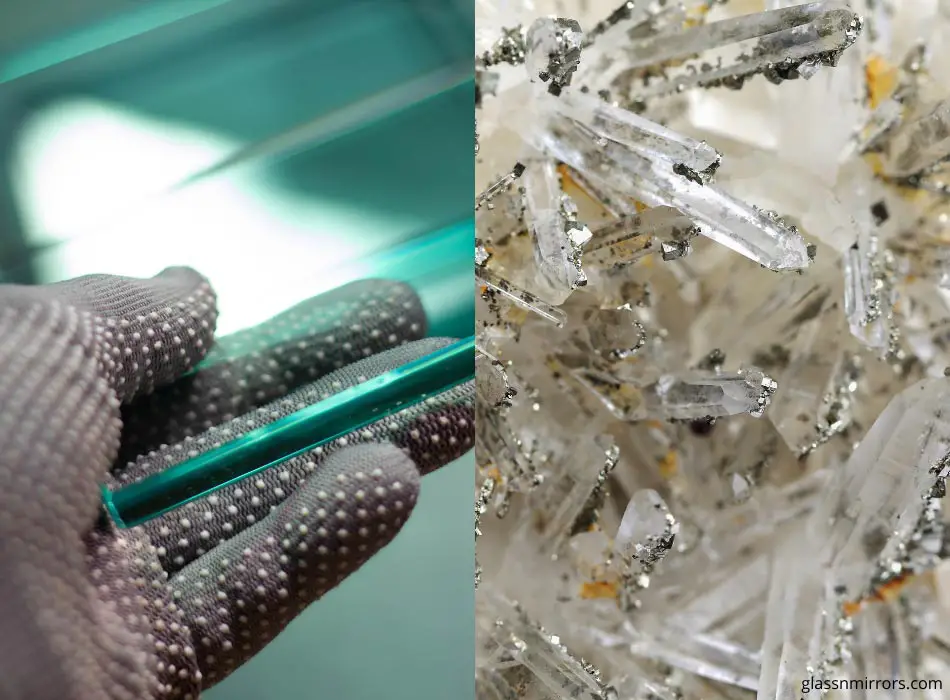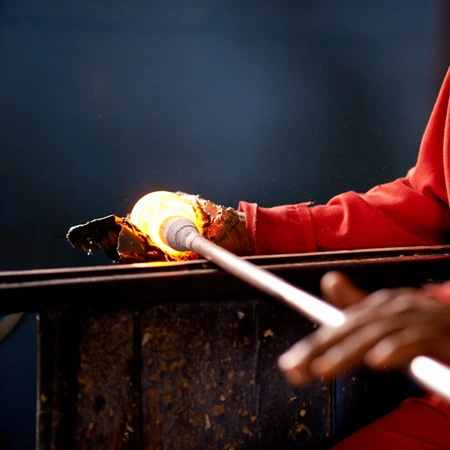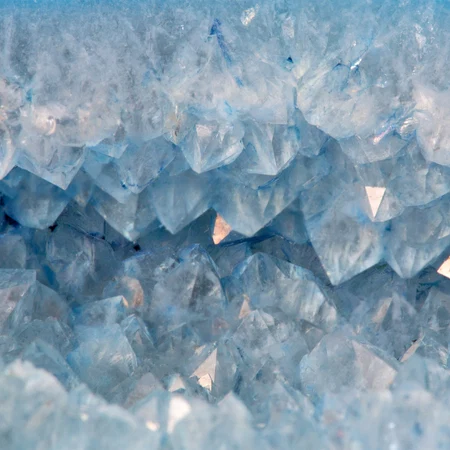It can be odd to hear about how glass comes from sand, which seems so opaque from afar. Being familiar with the glassmaking process and knowing the ins and outs of glassmaking, I can tell how essential sand is to the glassmaking process. But the contrarian in me always wonders whether it is possible to make glass without sand.
You can make glass without sand by extracting silica quartz from sources other than sand. Extracting silica from rocks and alternative sources is inefficient, expensive, and unnecessary, which is why sand remains the most-used source of silica for glassmaking, followed by ground-up old glass.
In this article, you will discover everything you need to know about glass making and sand, including the factors that contribute to sand being crucial for glass making and the kind of sand used to make glass. You will also discover other raw materials used in the process. Above all, you will finish reading this post with a complete understanding of the specific type of sand that is used for making glass.
Table of Contents
- 1 Why Is Sand Used to Make Glass?
- 2 Is All Glass Made From Sand?
- 3 What Kind of Sand Do You Need to Make Glass?
- 4 A Degree of Impurity
- 5 How to Tell Silica Sand Apart?
- 6 Other Uses of Silica Sand
- 7 Final Thoughts – Can You Make Glass Without Sand?
- 8 Hot Glass vs Cold Glass – What’s The Difference?
- 9 Can Quartz Be Made Into Glass? Guide On Quartz & Glass
- 10 What Is Panda Glass | Ultimate Guide To Panda Glass
- 11 What Is A Vanity Mirror – And Which One You Should Pick
Why Is Sand Used to Make Glass?

Sand is used to make glass because it is a rich source of easily accessible silica quartz. Alternative sources of silicate minerals do not carry enough of it or are extremely hard to extract or process. This leaves behind sand as the only source material used for large-scale glass manufacturing.
Can glass be converted to sand? I found out the truth and wrote about it in this article.
Ease of Availability
Any material item is a “product,” and all production depends on the cost of manufacturing. When raw material is easily available, it is cheaper simply because of the lack of scarcity.
When it comes to glass, high-silica sand is used because it is a relatively cheap raw material for making glass. This is not the only reason sand is used for glass manufacturing but is a factor that accounts for it.
If sand were more expensive than the glass is produced, it wouldn’t be used to make glass even as the only material that can produce glass. Glass production would stop, and an alternative would be brought to the market. This leads to the next factor, which covers the alternatives.
The Alternatives Produce a Fundamentally Different Product
The main reason glass is made from sand is that whatever is made from materials other than the ones found in the sand is not glass. It can be transparent and be used in windows, natural light sources, and even lenses, but it is not sand. Think of Beyond Meat, a brand that specializes in producing non-meat alternatives for commonly meat-based products.
The resemblance in taste and appearance can be brought about, but Beyond Meat patties aren’t technically meat. Sand-free glass is usually a flattened crystal or a super cooled liquid that has similar transparency, but it cannot qualify as glass because its contents are not the same as glass.
Ease of Disposability
Finally, the factor that ensures that sandglass (i.e., standard glass) is produced more often than regular glass is that the glass made from sand is easy to dispose of. But first, you must note that just because glass is made from sand doesn’t mean it naturally turns into sand.
My article on how long it takes for sand to become glass covers this topic further. Still, glass is easier to dispose of and almost infinitely recyclable. When glass made from sand comes with so much convenience for the manufacturers, there’s no reason to use other quartz as source material.
And that brings us to the state of the glass industry today, where a bulk of the glass is made from sand, and the rest is made/recycled from glass cullets (ground glass). Since color can be added to glass and its transparency can be changed without removing sand from the production process and remains the common raw material among all types of glass.
Glass can be made from other products other than sand!
Is All Glass Made From Sand?
All glass is made from sand, but one can technically manufacture glass without using regular sand. This process would involve extracting silica from stones or other sources, using soda ash and limestone to make the final product. But this process is more expensive and less practical.

In extracting and assembling the ingredients from sources other than sand, one would end up making artificial sand. And making more expensive sand to manufacture glass carries no commercial advantage. There is no market for sand-free glass, and regular glass is pretty feasible and environmentally friendly, which results in all glass being made from sand.
Contents of the Sand Matter
All glass is made from sand, but not all types of sand are used to make glass. This is because silica is the main material needed for making glass, and sand with a lower amount of silica crystals is likely to produce low-opacity glass in too small a quantity. For sand to be used for glassmaking, it must:
Contain a Higher Percentage of Silica
Silicon Dioxide crystals are the building blocks of glass, so sand that is not rich in silica may be used to create other supercooled liquids but can’t be used to make glass. Lower impurity levels – There are two types of impurities in the sand: interfering impurities (like iron minerals) and non-interfering impurities.
Non-interfering impurities do not affect the end result as they get incinerated in the manufacturing process. Almost everything naturally found in silica-rich sand aside from silicon dioxide is a non-interfering impurity.
However, sand with higher levels of interfering impurities cannot be used to make glass as the end product isn’t as transparent or durable.
Be closer to the production facility or easy to ship – Finally, the logistic aspect of the sand’s location is important. The manufacturing end of glass’s supply chain requires the sand to be closer to the production facility to minimize costs. However, this requirement is not essential, and one can technically ship sand from another country to make glass at home.
Glass Is More Than Just Sand
While sand is used to make all glass, not all that is used to make glass is sand. There are other products involved in making glass aside from the silica found in sand. Soda ash and limestone are the two non-silica ingredients used in manufacturing glass.
Wyoming has one of the largest commercially mineable soda ash deposits in the world. Limestone is available in relatively larger quantities and across many more spots, mainly in quarries. Sometimes, the sand and limestone are found in close proximity to each other and might even be in the same mound of sand.
If you’ve read my article that covers how glass is turned back into the sand, you know that ground-up glass can be used as raw material for making new glass. In such recycling processes, the ground-up glass acts as a source of silica, and new batches of other ingredients, soda ash, and limestone, are still required.
The temperature required to melt silica crystals
is over 3090°F!
HTTPS://WWW.CORNING.COM/WORLDWIDE/EN/INNOVATION/MATERIALS-SCIENCE/GLASS/HOW-GLASS-MADE.HTML
Everything That Looks Like Glass Isn’t Glass
Finally, you must keep in mind that not everything that looks like glass is made from sand. It is possible to craft material that resembles glass without using silica crystals. Supercooling liquified crystals of any sort lead to larger crystalline material.
The end product of the process can look like anything ranging from gems to glass. Usually, the non-silica crystals are used to produce jewelry and chandeliers, but sometimes glass alternatives are made for their durability.
What Kind of Sand Do You Need to Make Glass?
The only condition mandatory for sand to be used as source material for glassmaking is the presence of enough silica per batch. On average, a mound of sand must have 95% silica to qualify as fit for industrial glassmaking.
Other requirements can be fulfilled by alternative sources. But if the sand has a lower proportion of silica, it cannot form the clear crystalline sheets we are familiar with. Glass made from sand with less than 90% silica is not as transparent.
X-ray fluorescence analysis (XRF) is used to find out if a batch of sand has enough silica and is fit for glassmaking. Usually, this needs to be done when sand from a new site is added to the manufacturing process.
Once the XRF indicates that a certain region’s sand is fit for glassmaking, the manufacturer signs contracts to extract and use it. It is possible for some contracts to take a turn for the worse, with later batches having fewer silicate crystals.
This percentage drop is around 3%, which is why most manufacturers go for sands sources with up to 98% silica. Manufacturers who also use ground-up glass in their glassmaking process can use sand with lower silicate content.
A Degree of Impurity
Interestingly, pure glass cannot be used to remake glass. Given that glass is a supercooled liquid version of silicate sand, it can be turned back into a liquid after grinding. However, the cullets cannot be molten into a new glass sheet without adding impurities.
Temperature can affect glass. See how cold before a mirror breaks!
Similarly, silica sand that is simply a mound of silica cannot be used to feasibly make glass. That’s because the temperature required to melt silica crystals is over 3090°F. You need the following impurities to make glass from silica:
Soda Ash
Its addition reduces the melting point of the silicate substance, which allows glassmakers to manufacture glass without spending more money on heating. Alternatives that reduce silicate material’s melting point also affect its transparency, while soda ash improves the glass’s malleability without making it less clear. It is required when making glass from old glass cullets as well.
Limestone
the main function of limestone in glassmaking is to add durability to the final product. More specifically, limestone is Calcium Carbonate, which introduces Calcium Oxide to the glass recipe.
How to Tell Silica Sand Apart?
Now that you understand the importance of silica sand in making glass let’s go over how you can tell whether certain sand has high silicate content. Of course, you can go with a professional X-ray fluorescence analysis and get the final word of the sample. But often, this is not necessary as the sand’s visible characteristics giveaways its silicate content.
Silica sand can be spotted by:
- Observing sample reflection – A large batch of silica sand reflects sunlight with minimal color change.
- Looking at the sample color – Silica sand’s whiteness is directly proportional to its silicate content. The fewer impurities it has, the less grey or cream-colored it is.
- Conducting a moisture-absorption test – You should start by weighing a fistful of sand and then drenching it in water. If the sand absorbs close to 40% of its weight in water, it has high silica content.
Other Uses of Silica Sand
Knowing how to spot silica sand can be helpful for glassmaking as well as other construction material-related manufacturing. Silica sand is crucial to more than just glass production.
Some other construction products that feature silica sand as a structural component include:
- Flooring – Sand and crushed stone are used in conjunction to produce durable, stone-tier flooring. Even cement and asphalt used on the ground features sand, even if it doesn’t qualify as interior flooring.
- Roofing shingles – These are usually made from asphalt, which features sand as a traction-enhancing component.
- Asphalt – As covered above, sand is a component of construction-grade asphalt. While asphalt itself doesn’t contain sand it is poured with sand so that it has a more practical texture.
- Mortars – This is the adhesive used for construction, and it is made durable with the addition of sand.
- Cement – Cement itself might not contain sand, but when it is being mixed for application, the “cement powder” is mixed with sand so it can bind better with water. Without sand, cement not form a wet sludge that hardens after the excess water evaporates.
Final Thoughts – Can You Make Glass Without Sand?
You can make glass with silica quartz, limestone, and soda ash. These do not have to come from sand, but silica usually comes from the sand as it is too expensive to get from any other source. If you do not have access to sand and want to make glass, the next best option is to get cullets from a recycling facility.
For more glass and mirror tips be sure to visit us at Glass N Mirrors.

Hot Glass vs Cold Glass – What’s The Difference?

Can Quartz Be Made Into Glass? Guide On Quartz & Glass

What Is Panda Glass | Ultimate Guide To Panda Glass


3 thoughts on “Can You Make Glass Without Sand?”
Comments are closed.